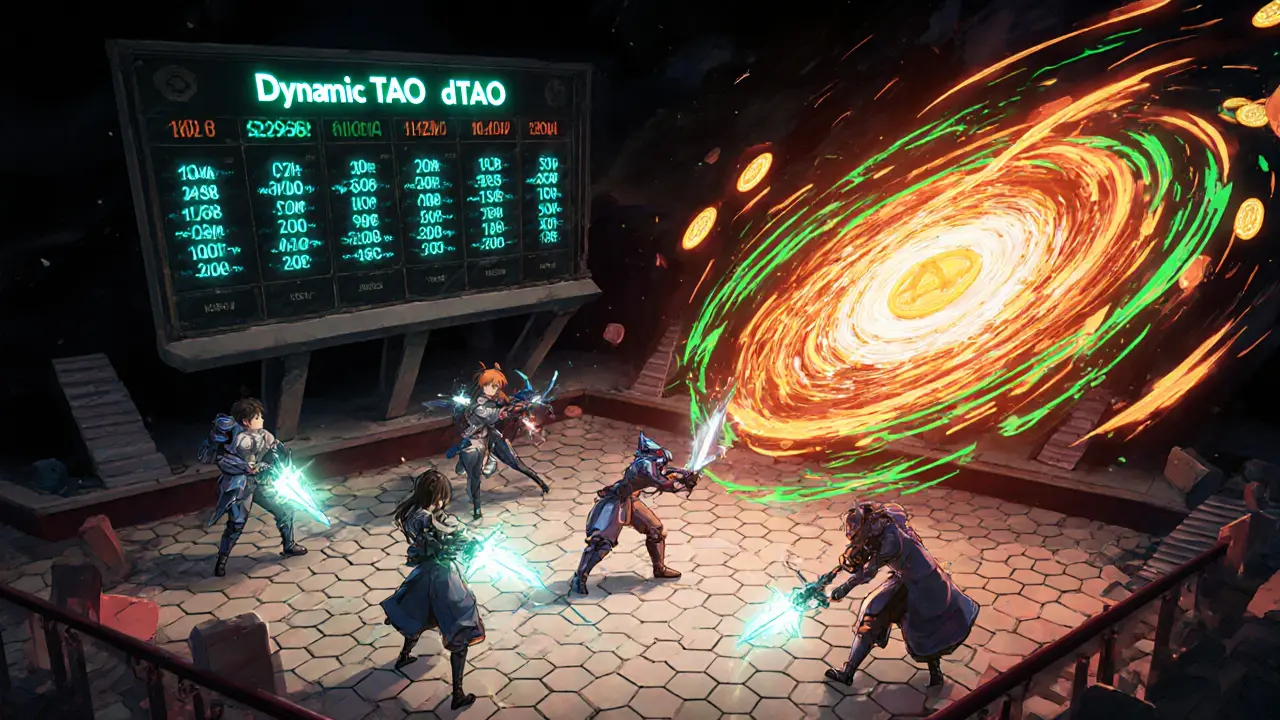TAO Rewards Calculator
This calculator estimates potential TAO earnings based on your GPU performance and subnet participation.
Bittensor is a decentralized blockchain network that builds a peer‑to‑peer market for artificial‑intelligence models. Its native crypto TAO acts as both a utility and staking token, rewarding participants for training, inference and validation work. If you’ve ever wondered why AI is still dominated by a handful of big players, Bittensor’s answer is simple: let anyone with a GPU contribute and get paid for genuine AI value.
Why Bittensor Exists - The Problem It Tries to Solve
Traditional AI development lives behind closed doors. Companies like OpenAI or Google own the data, the compute, and the models, meaning developers pay hefty fees for API access and users get answers filtered by corporate policy. Bittensor flips that script by turning AI models into digital commodities that can be bought, sold, and improved on an open ledger.
Imagine a global marketplace where a developer in Nairobi can rent out spare GPU cycles, a researcher in Berlin can sell a trained language model, and a startup in São Paulo can instantly query the best‑performing model for its specific task - all without a middle‑man taking a cut. That’s the economic promise behind the network.
Core Mechanics - How the Network Operates
At the heart of Bittensor is a novel consensus algorithm called Proof of Intelligence (PoI). Unlike Proof of Work, which rewards raw hashing power, PoI distributes TAO based on the measurable value of AI contributions. The network scores each model’s output against a set of benchmarks, then allocates rewards proportionally.
Key parameters:
- Block time: ~12 seconds, keeping the ledger fresh enough for real‑time AI pricing.
- Emission rate: 1 TAO per block, with a halving every 210,000 blocks (roughly four years).
- Supply cap: 21million TAO, mirroring Bitcoin’s scarcity model.
The first halving is slated for 24October2025, which historically triggers a price rally in many capped‑supply coins.
Dynamic TAO (dTAO) - Emissions That Follow Demand
In February2025 Bittensor introduced Dynamic TAO (dTAO), an adaptive emission framework. Subnets - specialised clusters of AI models - issue their own alpha tokens. The network then routes a slice of the overall TAO supply to whichever subnet’s alpha token shows the most market demand.
Think of dTAO as a live prediction market for AI performance: if a computer‑vision subnet is delivering state‑of‑the‑art object detection, investors buy its alpha token, and the subnet earns a higher share of TAO. Conversely, a lagging natural‑language subnet sees its share shrink. This self‑balancing mechanism pushes the entire ecosystem toward higher‑quality AI services.
Tokenomics - Why TAO Has Value
TAO’s value stems from three intertwined roles:
- Utility: Developers pay TAO to query models or to store data on the network.
- Staking: Token holders lock up TAO to secure the network and earn a portion of block rewards.
- Governance: Stakers vote on protocol upgrades, emission tweaks, and subnet parameter changes.
Because there was no pre‑mine, no ICO, and the team took zero allocation, early participants earned tokens purely by contributing AI work. This “fair launch” narrative has attracted institutional wallets - Polychain reportedly holds about $200million worth of TAO, while Digital Currency Group controls roughly $100million.
Current market snapshot (30Sept2025):
- Price: $304.50-$306.96 per TAO
- Circulating supply: 9,985,060 TAO
- Market cap: $3.07billion
- Rank: 37‑38 among all cryptocurrencies
Analysts project a 2025 price range between $1,063 and $1,152, implying a potential upside of 3‑4× the current level if the network’s AI services gain mainstream traction.

How Bittensor Differs from Centralized AI Platforms
| Feature | Bittensor (TAO) | OpenAI / Google AI |
|---|---|---|
| Governance | Token‑based voting by stakers | Corporate board decisions |
| Reward Model | Proof of Intelligence - paid for actual AI value | Subscription fees, usage‑based pricing |
| Access | Permissionless - anyone can run a node | Closed APIs, rate limits |
| Tokenomics | Capped at 21M TAO, no pre‑mine | Revenue‑driven, no native token |
| Data Censorship | Immutable ledger - hard to censor outputs | Subject to corporate policy and legal requests |
The table shows why many developers view Bittensor as the “Bitcoin of AI.” It isn’t just a token; it’s the economic glue that could unlock a truly open AI ecosystem.
Getting Started - Your First Steps with TAO
If you’re curious enough to try the network, here’s a quick cheat‑sheet:
- Create a wallet. Use a hardware wallet that supports the Substrate ecosystem or the official Bittensor desktop client.
- Acquire TAO. Buy on Binance, KuCoin, or via the wrapped ERC‑20 version on Uniswap.
- Stake TAO. Lock tokens in the staking UI to start earning a share of block rewards and gain voting power.
- Run a node. Deploy the open‑source node software on a machine with at least a modest GPU; the node will begin serving AI tasks and earning PoI rewards.
- Explore subnets. Browse the Bittensor Explorer to find subnets aligned with your expertise - computer vision, natural language, reinforcement learning, etc.
Most newcomers spend the first few weeks fine‑tuning their GPU setup and learning how the network scores their model. The community Discord and weekly AMA sessions are great places to ask questions.
Risks & Challenges - What Could Go Wrong
Like any early‑stage protocol, Bittensor faces several headwinds:
- Technical complexity. Running a productive node requires solid machine‑learning knowledge and reliable hardware.
- Market adoption. TAO’s price is tightly linked to real AI usage. If subnets fail to deliver compelling services, demand could wane.
- Alpha‑token dilution. Dynamic emissions may over‑reward certain subnets, potentially flooding the market with low‑quality alpha tokens.
- Regulatory scrutiny. As a token that pays for compute, regulators might categorize TAO as a utility token with specific compliance requirements.
Balancing these risks is why many analysts label TAO an “high‑potential, high‑uncertainty” asset. Diversify your exposure and keep an eye on subnet performance metrics.
Future Outlook - Where Bittensor Could Be in 2026
Looking ahead, several catalysts could push Bittensor into the mainstream:
- Enterprise integrations. If a major cloud provider offers a Bittensor‑backed AI marketplace, demand for TAO could explode.
- Regulatory clarity. A favorable ruling on token‑based AI services would lower legal risk for institutional investors.
- Breakthrough subnets. A subnet that beats the performance‑cost ratio of OpenAI’s GPT‑4 could attract massive user traffic.
Conversely, without clear use‑cases, the token may stay a niche speculation. The next 12 months will be decisive - especially after the October 2025 halving, which historically fuels price rallies in capped‑supply crypto.
Frequently Asked Questions
What is Bittensor’s native token?
The token is called TAO. It functions as a utility token for paying AI services, a staking token for securing the network, and a governance token for protocol upgrades.
How does Proof of Intelligence differ from Proof of Work?
Proof of Intelligence rewards participants based on the measurable value of AI contributions - such as model accuracy or speed - rather than raw computational hashes. This aligns incentives with the network’s core purpose: better AI.
Can I buy TAO on a regular crypto exchange?
Yes. TAO is listed on Binance, KuCoin, Bitget, and can also be bought as the wrapped ERC‑20 version on Uniswap via the Tensorplex Labs bridge.
What is Dynamic TAO (dTAO)?
dTAO is an adaptive emission scheme introduced in 2025. It allocates a portion of the overall TAO supply to individual subnets based on market demand for their native alpha tokens, creating a live prediction market for AI performance.
Is Bittensor a good short‑term investment?
Most analysts see TAO as a long‑term play. Recent price dips may offer entry points, but the token’s short‑term volatility and reliance on actual AI utility make it risky for quick flips.






Comments
april harper
October 1, 2025 AT 02:18 AMIn the grand theatre of decentralized AI, Proof of Intelligence writes its own script, rewarding not the loudest hash but the sharpest insight. Every GPU that dares to contribute becomes a character on a stage where value is measured in accuracy and speed. The network’s token, TAO, acts like applause, echoing the merit of each model’s performance. This paradigm shift feels almost poetic, turning cold computation into a living marketplace of ideas. It’s a reminder that even in code, we can find a rhythm that mirrors human collaboration.
Kate Roberge
October 1, 2025 AT 13:25 PMHonestly, the whole "Bitcoin of AI" hype feels a bit overblown. Sure, decentralization is cool, but stacking another token on top of existing cloud services doesn’t automatically solve the data quality problem. You still need robust datasets and clever engineers to train anything useful. And the market dynamics for alpha tokens? Still pretty speculative. I’d keep an eye on actual usage metrics before buying the hype train.
VICKIE MALBRUE
October 2, 2025 AT 00:31 AMLooks like a solid chance for folks with spare GPU cycles to earn while learning about AI. The calculator gives a quick way to gauge potential earnings without too much hassle. It’s great to see a project that rewards actual AI work rather than just mining power.
Waynne Kilian
October 2, 2025 AT 11:38 AMi think its a nice try to bring more peoples into ai work though some of the tech documetnation can be a bit hard to follow. still, the idea of a global market for models feels like a step towards more open innovation. hope they keep improving the ux and fix the small bugs.
Naomi Snelling
October 2, 2025 AT 22:45 PMNever trust a system that hands out money for running AI models without strict oversight. One day regulators will crack down and the whole thing could vanish. It’s a quiet way of funneling compute power into opaque networks – something to watch.
Michael Wilkinson
October 3, 2025 AT 09:51 AMListen up: if you’re not ready to protect your hardware and monitor your node 24/7, stay out. The rewards are tempting, but a single hardware failure can wipe out weeks of earned TAO. Invest in reliable rigs and keep your rigs cool; otherwise you’ll be left in the cold.
Billy Krzemien
October 3, 2025 AT 20:58 PMFor anyone new to Bittensor, start by staking a modest amount of TAO to get a feel for the reward curve. After that, allocate a dedicated GPU to a subnet that matches your expertise – computer vision or language models work best for most users. Monitor the subnet’s alpha token performance; if it drops, consider re‑allocating to a higher‑performing subnet. Consistency and patience are key to building steady earnings.
Carl Robertson
October 4, 2025 AT 08:05 AMDrama aside, the real question is whether any subnet can truly outperform the big cloud providers on cost‑per‑accuracy. So far, the numbers look promising, but we need more real‑world benchmarks before declaring victory. Keep an eye on the upcoming performance reports and let’s see who delivers the real punch.
Rajini N
October 4, 2025 AT 19:11 PMWhen setting up a node, make sure your OS and drivers are up to date. The latest CUDA toolkit can give you a noticeable boost in throughput, directly increasing your TAO rewards. Also, join the Discord channels for each subnet – they often share tips on optimizing model inference pipelines.
Oreoluwa Towoju
October 5, 2025 AT 06:18 AMCheck subnet performance daily, move GPU if needed.
Jason Brittin
October 5, 2025 AT 17:25 PMWow, another token promising to fix AI? 🙄 Let’s hope this one actually delivers something beyond the usual hype.
Amie Wilensky
October 6, 2025 AT 04:31 AMWell-here-comes-a-serious-look-at-how-Proof-of-Intelligence-could-reshape-AI-deployment-in-the-future--It's-quite-intriguing--but-only-time-will-tell-if-the-market-adopts-this-model--in-any-case-keep-watching-the-metrics--!
Lindsay Miller
October 6, 2025 AT 15:38 PMI appreciate the effort to make AI more accessible, but the learning curve is still steep for newcomers. Simple guides and clearer documentation would help bridge that gap.
Katrinka Scribner
October 7, 2025 AT 02:45 AMlol i think its soooo cool but also kinda scaryyy you never know who might be watching your models 🤔
Clint Barnett
October 7, 2025 AT 13:51 PMStepping back and looking at the broader picture, Bittensor presents an ambitious attempt to democratize the AI economy, which traditionally has been the playground of tech giants with deep pockets. By introducing a token‑based incentive layer, the protocol essentially monetizes the marginal improvements in model performance, turning every fraction of a percent gain into a tangible economic reward. This shift could incentivize a massive influx of hobbyist and academic contributors who otherwise lack the financial backing to compete in the AI race. Moreover, the dynamic TAO (dTAO) mechanism adds a market‑driven allocation of resources, ensuring that subnets delivering real value capture a larger share of the emission pool. In practice, this means that a cutting‑edge computer‑vision subnet could see its token supply swell, funding further research and attracting more participants. The feedback loop created by dTAO mirrors real‑world supply‑and‑demand dynamics, potentially fostering rapid innovation cycles. However, the system is not without its vulnerabilities; if a subnet’s alpha token inflates without delivering commensurate performance, it could lead to token dilution and erode trust. The network’s reliance on benchmarks also raises questions about which metrics truly capture utility across diverse applications. Another consideration is the scalability of the underlying substrate; as more nodes join, the blockchain must handle increased transaction volume without compromising latency, which is crucial for real‑time inference services. Regulatory scrutiny is also on the horizon, especially as jurisdictions grapple with classifying utility tokens that pay for compute services. Despite these challenges, the core idea of aligning incentives with measurable AI contributions is compelling and could reshape the tokenomics of future decentralized compute platforms. If Bittensor can maintain robust security, transparent governance, and a vibrant ecosystem of subnets, it stands a real chance of becoming a cornerstone of the next generation of AI infrastructure.
Jacob Anderson
October 8, 2025 AT 00:58 AMSure, another crypto promising world peace.
MD Razu
October 8, 2025 AT 12:05 PMBuilding on the previous point, the long‑term sustainability of TAO hinges on continuous, verifiable improvements in model outputs across all subnets. If developers start gaming the benchmark system, we could see a scenario where token rewards no longer reflect genuine AI progress, undermining the protocol’s credibility. Hence, rigorous, multi‑dimensional evaluation frameworks are essential to guard against such manipulation. Additionally, community governance must stay proactive in updating these metrics to keep pace with emerging AI techniques.
Charles Banks Jr.
October 8, 2025 AT 23:11 PMSounds like a solid plan-let's keep the tests transparent.
Ben Dwyer
October 9, 2025 AT 10:18 AMNice breakdown, but remember to keep the firewall active when you spin up those nodes; you don’t want unwanted traffic sneaking in.
april harper
October 9, 2025 AT 21:25 PMWhile sarcasm may mask uncertainty, the underlying pursuit of open AI is undeniably noble, and each contribution, however small, stitches together a tapestry of shared intelligence.